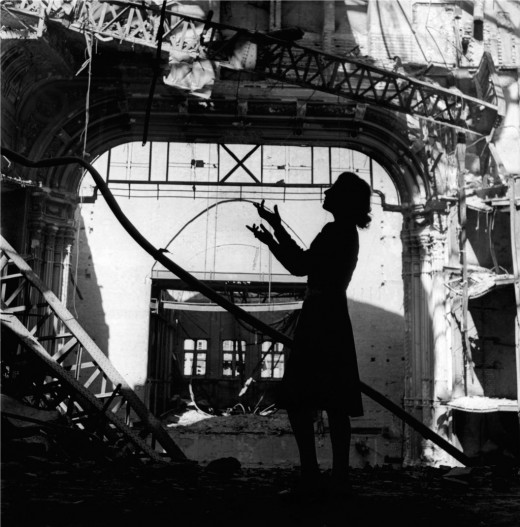 Lee Miller, Irmgard Seefried, Opera singer singing an aria from ‘Madame Butterfly’, 1945. Modern exhibition digital print. The exhibition was organized in cooperation with the Albertina, Vienna. © Lee Miller Archives, England 2015. All rights reserved
Lee Miller, Irmgard Seefried, Opera singer singing an aria from ‘Madame Butterfly’, 1945. Modern exhibition digital print. The exhibition was organized in cooperation with the Albertina, Vienna. © Lee Miller Archives, England 2015. All rights reserved
OCTOBER 4, 2015–FEBRUARY 14, 2016
You might say that artist Elizabeth “Lee” Miller (1907–1977)—super model, surrealist photographer, and war correspondent—is trending. There’s talk of a movie starring Kate Winslet. Four recent and current exhibitions in North America and Europe are featuring her photos. One of these is The Indestructible Lee Miller at NSU Art Museum Fort Lauderdale.
The exhibition follows Miller’s creative practice as it comes into focus and dissolves, beginning and ending with black-and-white photographs in which she is the subject. The first set of images reveal what happened in the late 1920s after she abandoned her role as a fashion model in New York and moved to Paris to apprentice with avant-garde photographer Man Ray. Miller’s mentor soon became her lover and her artistic collaborator. In most of the photographs on view here, Ray deconstructs Miller’s beauty. He obsessed on her body, often fragmenting her torso, her breasts, her neck, her lips, and her silhouette in his work. In fact, the exhibition’s title refers to one such instance. Indestructible Object, a 1923 sculpture of a metronome that Ray altered after their 1932 breakup, features Miller’s eye.
In this show, we watch Miller reverse the gaze by positioning herself behind the lens. Images taken in Paris and New York illustrate her own surrealist aesthetic. She achieved the energy of Exploding Hand (1930) simply by capturing one gesture—a woman’s hand opening the glass door of a Guerlain boutique in Paris that had been scratched by countless diamond rings. Beyond gorgeous, the photo seems to comment on the destructive nature of privilege and wealth.
Lee was soon to make more overt social, feminist, and political statements. She abstracted and empowered the female body in a radical series of nude photographs. Perhaps her most violent critique of female objectification is Untitled (Severed Breast from Radical Mastectomy), the 1930 photograph she composed after observing a mastectomy. She carried the severed breast to her studio and photographed it on a white plate with a knife and fork. More than eighty-five years later, the image she printed twice to exhibit as a diptych still has the power to shock.
At a time when women weren’t permitted to serve in the armed forces, the camera effectively became the means for Miller to comment on World War II. In London, for example, she shot fashion photographs for British Vogue on the streets of a city devastated by air raids. Miller realized her fullest potential as one of five accredited female photojournalists embedded in American forces that liberated concentration camps in 1945. She documented the trauma of liberated victims, avenged perpetrators, and stunned liberators in tightly cropped scenes at Dachau and Buchenwald.
Miller is the subject of the photograph that surely represents the climax of her career as an artist. Shortly after Adolf Hitler’s suicide in 1945, his Munich apartment became a US Army command post. She was quartered there, with friend and colleague Dave Scherman, a Life magazine photographer. Scherman took the photo that pictures Miller posing nude in Hitler’s bathtub, her muddy combat boots on the white tile floor. An official photograph of Hitler is placed on the edge of the tub. Again becoming the subject of the gaze, through Scherman, Miller remarks on her bitter fascination with the atrocities she had witnessed and recorded. As she looks directly at the camera, she acknowledges that she (and by extension, the world) will be forever marked by the experience.









